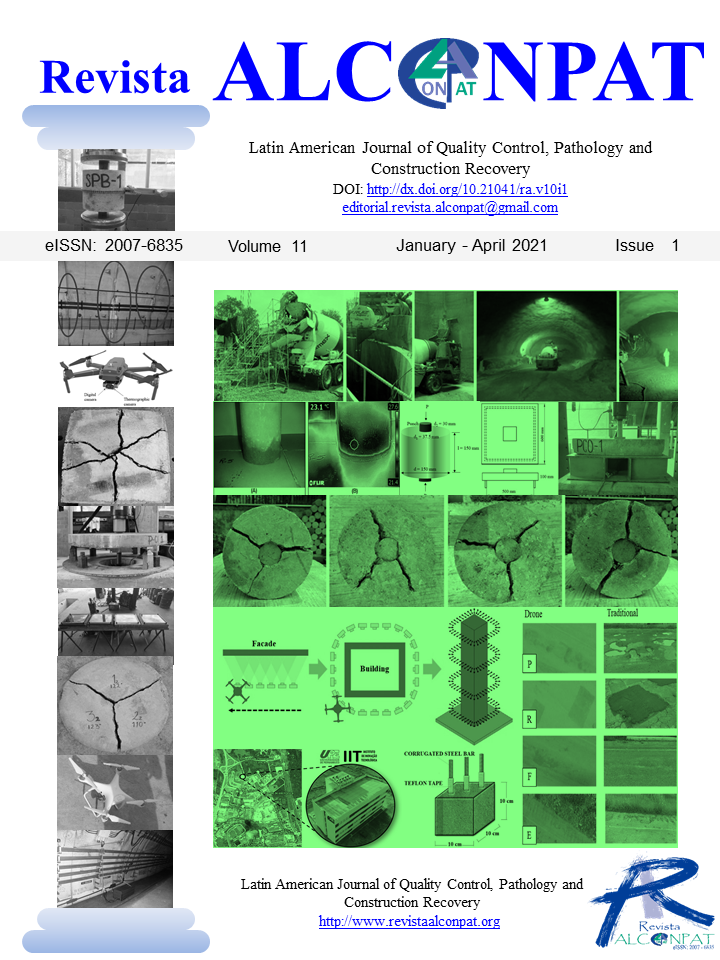Inspection of facades with Unmanned Aerial Vehicles (UAV): an exploratory study
DOI:
https://doi.org/10.21041/ra.v11i1.517Keywords:
UAV, property inspection, visual inspection, monitoring, aerial photosAbstract
The objective of this study was to evaluate the use of Unmanned Aerial Vehicles (UAVs) as a visual tool for the inspection of pathological manifestations in facades, through an exploratory study. Currently, the relevance of UAVsis growing as a new mechanism for obtaining data and visual inspection of buildings, optimizing time. The research strategy had three distinct steps: a literature review, an experimental procedure, and data processing, aiming to verify the viability of the inspection procedure. There is evidence of the convenience of UAV use, particularly where access is difficult, which reduces time and cost, generates greater security, and allows 3D reconstruction of the building under inspection, generating more accurate diagnoses.
Downloads
References
Agostinho, S. L. (2012), “Inspeção e Monitorização de Estruturas em Engenharia Civil – Utilização de UAV na Inspeção e Monitorização”, Masther’s Thesis, Universidade da Madeira, p. 105.
Álvares, J., Costa, D. B., Melo, R. R. S., Bello, A. (2016). “Estudo exploratório de mapeamento 3D de canteiros de obras utilizando veículos aéreos não tripulados” in: VI ENTAC, São Paulo: São Paulo (Brasil).
Ballesteros, R. (2020), “Inspeção de manifestações patológicas de fachadas utilizando Veículo Aéreo Não Tripulado (VANT): estudo exploratório”, Masther’s Thesis, Escola Politécnica de Pernambuco, Universidade de Pernambuco, p. 220.
Brasil. Agência Nacional de Aviação Civil. Requisitos gerais para aeronaves não tripuladas de uso civil - RBAC-E nº 94. Resolução n. 419, 2 de maio de 2017. Brasília, 2017.
De Melo, R., Costa, D., Álvares, J., Irizarry, J. (2017), Applicability of unmanned aerial system (UAS) for safety inspection on construction sites. Safety Science. 98:174-185. https://doi.org/10.1016/j.ssci.2017.06.008
DJI (2017). Phantom 4 Pro Homepage. Recuperado em 26 de setembro de 2020 de https://dl.djicdn.com/downloads/phantom_4_pro/20170719/Phantom_4_Pro_Pro_Plus_User_Manual_EN.pdf
Emelianov, S., Bulgakow, A., Sayfeddine, D. (2014). “Aerial laser inspection of buildings facades using quadrotor” in: Creative Construction Conference, Prague (Czech Republic).
EXAME. Revista Online Grupo Abril. (2016). Recuperado em 26 de setembro de 2020 de https://www.exame.abril.com.br
Falorca, J. F., Lanzinha, J. C. G. (2020). Facade inspections with drones–theoretical analysis and exploratory tests. International Journal of Building Pathology and Adaptation, ahead-of-print. https://doi.org/10.1108/IJBPA-07-2019-0063
Flores-Colen, I., De Brito, J., De Freitas, V. (2018). Stains in facades’ rendering – Diagnosis and maintenance techniques’ classification. Construction and Building Materials. 22(3):211-221. https://doi.org/10.1016/j.conbuildmat.2006.08.023
Groetelaars, N. J. (2015), “Criação de modelos BIM a partir de nuvens de pontos: estudo de métodos e técnicas para documentação arquitetônica”, Doctoral Dissertation, Universidade Federal da Bahia, Faculdade de Arquitetura, Brasil.
Grosso, R., Mecca, U., Moglia, G., Prizzon, F., Rebaudengo, M. (2020). Collecting Built Environment Information Using UAVs: Time and Applicability in Building Inspection Activities. Sustainability. 12:4731. https://doi.org/10.3390/su12114731
Hung, M. N. W. B., Sampaio, T. V. M., Schultz, G. B., Siefert, C. A. C., Lange, D. R., Marangon, F. H. S., Santos, I. (2018). Levantamento com veículo aéreo não tripulado para geração de modelo digital do terreno em bacia experimental com vegetação florestal esparsa. Revista Ra'e Ga Espaço Geográfico em Análise. 43:215-231. http://dx.doi.org/10.5380/raega.v43i0.56621
ICAO - International Civil Aviation Organization. (2017). Remotely Piloted Aircraft System (RPAS) concept of operations for international IFR operations. ICAO (USA), p. 30.
Irizarry, J., Costa, D.B. (2016). Exploratory Study of Potential Applications of Unmanned Aerial Systems for Construction Management Tasks. Journal of Management in Engineering. 32(3):1-10. https://doi.org/10.1061/(ASCE)ME.1943-5479.0000422
Kim, S., Irizarry, J., Costa, D. B., Mendes, A. T. C. (2016). “Lessons learned from unmanned aerial system-based 3D mapping experiments” in: 52nd ASC Anual International Conference, Provo: Utah (USA).
Liberati, A., Altman, D. G., Tetzlaff, J., Mulrow, C., Gotzsche, P. C., Ioannidis, J. P. A., Clarke, M., Devereaux, P., Kleijnen, J., Moher, D. (2009). The PRISMA statement for reporting systematic reviews and meta-analyses of studies that evaluate healthcare interventions: explanation and elaboration. BMJ, 339:b2700–b2700. https://doi.org/10.1136/bmj.b2700
Mader, D., Blaskow, R., Westfeld, P., Weller, C. (2016). Potential of UAV-Based laser scanner and multispectral camera data in building inspection. International Archives of the Photogrammetry, Remote Sensing and Spatial Information Sciences. XLI-B1:1135-1142. https://doi.org/10.5194/isprs-archives-XLI-B1-1135-2016
Mathe, K., Busoniu, L. (2015). Vision and Control for UAVs: A Survey of General Methods and of Inexpensive Platforms for Infrastructure Inspection. Sensors. 15(7):14887-14916. https://doi.org/10.3390/s150714887
Melo Jr., C. M. (2016), “Methodology for generating façade damage maps from unmanned aerial vehicle photographs and digital image processing”, Doctoral Dissertation, Universidad de Brasilia, Brasil.
Melo, R. R. S., Costa, D. B. (2015). “Uso de veículo aéreo não tripulado (VANT) para inspeção de logística em canteiros de obra” in: SIBRAGEC-ELAGEC, São Carlos: São Paulo (Brasil).
Morgenthal, G., Hallermann, N. (2014). Quality Assessment of Unmanned Aerial Vehicle (UAV) Based Visual Inspection of Structures. Advances in Structural Engineering. 17(3):289-302. https://doi.org/10.1260/1369-4332.17.3.289
Nascimento, M. L. M. (2017), “Utilização de drone e termografia na detecção de manifestações patológicas em edificações”, Monograph, Universidade Católica de Brasília, p. 21.
Nikolic, J., Burri, M., Rehder, J., Leutenegger, S., Huerzeler, C., Siegwart, R. (2013). “A UAV system for inspection of industrial facilities” in: 2013 IEEE Aerospace Conference, Big Sky: Montana (USA). https://doi.org/10.1109/AERO.2013.6496959
Pacheco, C., Vieira, G. (2017). “Metodologias para Inspeções de Fachadas de Edifícios” in: IV CIRMARE - Congresso Internacional na Recuperação, Manutenção e Restauração de Edifícios, São Paulo: São Paulo (Brasil).
Pierrot-Deseilligny, M., De Luca, L., Remondino, F. (2011). Automated image-based procedures for accurate artifacts 3D modeling and orthoimage generation. Geoinformatics CTU FCE. 6:291-299. https://doi.org/10.14311/gi.6.36
PiórkowskI, D. T. (2008). “Rectification and Intermediate View synthesis”, Monograph, Universitat Politecnica de Catalunya, p. 47.
Pires, R., De Brito, J., Amaro, B. (2015). Inspection, Diagnosis, and Rehabilitation System of Painted Rendered Façades. Journal of Performance of Constructed Facilities. 29(2):1-9. https://doi.org/10.1061/(ASCE)CF.1943-5509.0000534
Rakha, T., Gorodetsky, A. (2018). Review of Unmanned Aerial System (UAS) applications in the built environment: Towards automated building inspection procedures using drones. Automation in Construction. 93:252–264. https://doi.org/10.1016/j.autcon.2018.05.002
Reagan, D., Sabato, A., Niezrecki, C. (2018). Feasibility of using digital image correlation for unmanned aerial vehicle structural health monitoring of bridges. Structural Health Monitoring. 17(5):1056-1072. https://doi.org/10.1177/1475921717735326
Roca, R., Lagüela, S., Díaz-Vilariño, L., Armesto, J., Arias, P. (2013). Low-cost aerial unit for outdoor inspection of building façades. Automation in Construction. 36:128-135. https://doi.org/10.1016/j.autcon.2013.08.020
Rodriguez-Gonzalvez, P., Gonzalez-Aguilera, D., Lopez-Jimenez, G., Picon-Cabrera, I. (2014). Image-based modeling of built environment from an unmanned aerial system. Automation in Construction. 48:44-52. https://doi.org/10.1016/j.autcon.2014.08.010
Ruiz, R. D. B., Lordsleem Júnior, A. C., Fernandes, B. J. T., Oliveira, S. C. (2021). Unmanned Aerial Vehicles and Digital Image Processing with Deep Learning for the Detection of Pathological Manifestations on Facades. In: Toledo Santos E., Scheer S. (eds) Proceedings of the 18th International Conference on Computing in Civil and Building Engineering. ICCCBE 2020. Lecture Notes in Civil Engineering, vol 98. Springer, Cham. https://doi.org/10.1007/978-3-030-51295-8_76
Shariq, M. H., Hughes, B. R. (2020). Revolutionising building inspection techniques to meet large-scale energy demands: A review of the state-of-the-art. Renewable and Sustainable Energy Reviews. 130:109979. https://doi.org/10.1016/j.rser.2020.109979
Tondelo, P. G., Barth, F. (2019). Análise das manifestações patológicas em fachadas por meio de inspeção com VANT. PARC Pesquisa Em Arquitetura E Construção, 10, e019009. https://doi.org/10.20396/parc.v10i0.8652817
Vera-Rozo, E. (2016). Medición de contaminación mediante UAV (Vehículo Aéreo no Tripulado). Mundo FESC. 6(11): 16-26.
Yang, X., Qin, X., Wang, J., Wang, J., Ye, X., Qin, Q. (2015). Building Façade Recognition Using Oblique Aerial Images. Remote Sensing. 8(7): 10562-10588. https://doi.org/10.3390/rs70810562
Downloads
Published
How to Cite
Issue
Section
License
_______________________________
License in effect from September 2020
You are free to:
- Share — copy and redistribute the material in any medium or format for any purpose, even commercially.
- Adapt — remix, transform, and build upon the material for any purpose, even commercially.
- The licensor cannot revoke these freedoms as long as you follow the license terms.
Under the following terms:
- Attribution — You must give appropriate credit , provide a link to the license, and indicate if changes were made . You may do so in any reasonable manner, but not in any way that suggests the licensor endorses you or your use.
- No additional restrictions — You may not apply legal terms or technological measures that legally restrict others from doing anything the license permits.
Notices:
You do not have to comply with the license for elements of the material in the public domain or where your use is permitted by an applicable exception or limitation .
No warranties are given. The license may not give you all of the permissions necessary for your intended use. For example, other rights such as publicity, privacy, or moral rights may limit how you use the material.





















.png)














